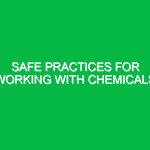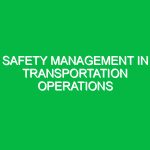Introduction
Safety in Research and Development (R&D) facilities is not just a regulatory requirement; it is a fundamental aspect of fostering innovation while protecting the well-being of employees and the environment. R&D environments are typically dynamic and complex, characterized by the use of cutting-edge technologies, experimental procedures, and hazardous materials. Consequently, the relevance of robust Health, Safety, and Environment (HSE) practices cannot be overstated. Effective safety measures are critical to minimizing risks, ensuring compliance with regulations, and creating a culture of safety that permeates the organization.
Imagine a laboratory bustling with researchers, each engrossed in their projects, from developing new pharmaceuticals to testing innovative materials. In such settings, the potential for accidents, exposure to harmful substances, and equipment malfunctions is high. Thus, understanding the safety protocols and implementing them rigorously can mean the difference between success and disaster. This article delves deep into the essential aspects of safety in R&D facilities, identifying hazards, outlining safety precautions, and discussing relevant regulations.
Identifying Hazards and Risks in Research and Development Facilities
The dynamic nature of R&D facilities exposes them to a variety of hazards. Understanding these potential risks is the first step towards effective safety management.
Chemical Hazards
One of the primary concerns in R&D settings is the handling of hazardous chemicals. These substances can range from corrosive agents to toxic compounds. For instance, a study conducted by the National Institute for Occupational Safety and Health (NIOSH) indicated that improper handling of chemicals is responsible for a significant number of laboratory accidents. Researchers must be adequately trained to understand Material Safety Data Sheets (MSDS) and recognize chemical properties, hazards, and required precautions.
Biological Hazards
In facilities involved in biological research, the risk of exposure to pathogens is a critical concern. Laboratories working with bacteria, viruses, or other microorganisms must adhere to stringent biosafety protocols. An anecdote from an experienced lab manager illustrates the importance of such protocols: “We once had a near-miss incident where a vial containing a pathogenic strain was mistakenly left uncapped. Fortunately, our team was trained to recognize the risk and acted swiftly to contain the situation.” This emphasizes that vigilance and proper training can prevent potentially catastrophic errors.
Physical Hazards
Physical hazards, such as slips, trips, and falls, are commonplace in R&D facilities. The presence of cables, wet floors, and uneven surfaces can contribute to accidents. Additionally, equipment malfunction or improper use can lead to serious injuries. For instance, a researcher might sustain injuries if safety guards on machinery are removed for maintenance without proper lockout/tagout procedures.
Ergonomic Hazards
Long hours spent in uncomfortable positions can lead to musculoskeletal disorders. Researchers often find themselves hunched over microscopes or working at computers for extended periods. Implementing ergonomic assessments and workstation adjustments can mitigate these risks.
Psychosocial Hazards
The mental health of employees also plays a crucial role in the overall safety of R&D facilities. High-pressure environments can lead to stress, anxiety, and burnout, impacting both individual well-being and team performance. Encouraging open communication and providing mental health resources can help alleviate these concerns.
Safety Precautions and Best Practices in Research and Development Facilities
Once hazards are identified, the next step is to implement effective safety precautions. Here are some best practices tailored for R&D facilities:
Comprehensive Training Programs
Training is the cornerstone of safety in any facility. Employees should undergo regular training sessions that cover hazard recognition, emergency response procedures, and the proper use of personal protective equipment (PPE). For instance, a pharmaceutical company that introduced quarterly safety drills significantly reduced incidents related to chemical spills.
Proper Use of Personal Protective Equipment (PPE)
Ensuring that employees use appropriate PPE, such as lab coats, gloves, goggles, and respirators, is essential. The selection of PPE should correspond to the specific hazards present in the facility. Regular inspections of PPE for wear and tear should also be conducted.
Implementation of Standard Operating Procedures (SOPs)
Establishing and enforcing SOPs for all procedures can minimize risks. These should be clearly documented and easily accessible. For example, a lab working with volatile chemicals should have a dedicated SOP for safe handling and storage. Regular reviews of these procedures ensure they remain relevant and effective.
Emergency Preparedness and Response Plans
Every facility must have a comprehensive emergency preparedness plan. This includes evacuation routes, first aid procedures, and emergency contact numbers. Conducting regular drills will ensure that employees are familiar with procedures and can respond effectively in case of an emergency.
Regular Safety Audits and Risk Assessments
Conducting regular safety audits and risk assessments helps identify potential hazards before they lead to incidents. These assessments should be thorough and involve all employees, as they can provide insights into overlooked risks.
Regulations and Standards Governing Safety in Research and Development Facilities
Compliance with regulations is a critical aspect of safety in R&D facilities. Various agencies govern safety standards, including:
Occupational Safety and Health Administration (OSHA)
OSHA sets and enforces standards to ensure safe working conditions. Facilities must comply with OSHA regulations regarding hazard communication, PPE, and laboratory safety standards.
Environmental Protection Agency (EPA)
The EPA regulates the management of hazardous waste, requiring facilities to follow stringent disposal procedures. Compliance helps prevent environmental contamination and ensures the safety of surrounding communities.
National Institute for Occupational Safety and Health (NIOSH)
NIOSH provides research and recommendations for the prevention of work-related injuries and illnesses. Facilities should refer to NIOSH guidelines for best practices in health and safety.
American National Standards Institute (ANSI)
ANSI develops consensus standards for various industries, including laboratory safety. Adhering to ANSI standards can enhance safety protocols and practices in R&D settings.
Conclusion
The significance of safety in research and development facilities cannot be overstated. By identifying potential hazards and implementing robust safety measures, organizations can protect their employees and foster a culture of safety that enhances productivity and innovation. From comprehensive training programs to adherence to regulatory standards, each aspect contributes to a safer working environment.
In an era where research drives progress, ensuring safety is not just a legal obligation; it is a moral imperative. As we move forward, let us remember that safety is a shared responsibility, and every individual plays a crucial role in maintaining a safe and productive R&D facility.


